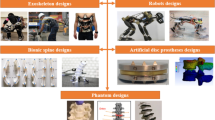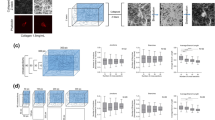Abstract
Vibrational stimulation is an accepted non-invasive method used to improve bone remodeling. However, the underlying mechanisms of this phenomenon remain unclear. In this study, we developed a new vibration-loading system to apply vibrational stimulation to cells based on a previously reported in vivo study. We hypothesized that osteoblasts respond to vibrational strain by expressing osteogenic marker genes, such as alkaline-phosphatase (ALP), Runx2, and Osterix. To test our hypothesis, we developed a vibration-loading system to apply a precise vibrational force to an osteoblast culture on a silicone membrane. The system regulated frequency and acceleration of the vibration, and strain on the silicone membrane culture surface was measured using the strain gauge method. After vibrational stimulation, cellular gene expression was analyzed using real-time polymerase chain reaction. We obtained clear strain signals from the culture surface at vibrational ranges of 1.0–10 m/s2 acceleration and frequencies of 30, 60, and 90 Hz, respectively. The strain increased in a linear fashion, depending on the acceleration magnitude. Vibrational stimulation also significantly upregulated expression of the osteogenic marker genes Runx2, Osterix, type I collagen, and ALP. In conclusion, we developed a new vibration-loading system that can precisely regulate frequency and acceleration, and we established the presence of dynamic cellular strain on a culture surface. Our findings suggest that vibrational stimulation may directly induce osteoblast differentiation.







Similar content being viewed by others
References
Bacabac RG, Smit TH, Van Loon JJ, Doulabi BZ, Helder M, Klein-Nulend J (2006) Bone cell responses to high-frequency vibration stress: Does the nucleus oscillate within the cytoplasm? FASEB J 20:858–864
Beck BR (2015) Vibration therapy to prevent bone loss and falls: mechanisms and efficacy. Curr Osteoporos Rep 13:381–389
Dumas V, Ducharne B, Perrier A, Fourier C, Guignandon A, Thomas M, Peyroche S, Guyomar D, Vico L, Rattner A (2010) Extracellular matrix produced by osteoblasts cultured under low-magnitude, high-frequency stimulation is favorable to osteogenic differentiation of mesenchymal stem cells. Calcif Tissue Int 87:351–364
Edwards JH, Reilly GC (2015) Vibration stimuli and the differentiation of musculoskeletal progenitor cells: review of results in vitro and in vivo. World J Stem Cells 7:568–582
Eriksen EF (2010) Cellular mechanisms of bone remodeling. Rev Endocr Metab Disord 11:219–227
Gilbert JA, Weinhold PS, Banes AJ, Link GW, Jones GL (1994) Strain profiles for circular cell culture plates containing flexible surfaces employed to mechanically deform cells in vitro. J Biomech 27:1169–1177
Harada H, Tagashira S, Fujiwara M, Ogawa S, Katsumata T, Yamaguchi A, Komori T, Nakatsuka M (1999) Cbfa1 isoforms exert functional differences in osteoblast differentiation. J Biol Chem 274:6972–6978
Hou WW, Zhu ZL, Zhou Y, Zhang CX, Yu HY (2011) Involvement of Wnt activation in the micromechanical vibration-enhanced osteogenic response of osteoblasts. J Orthop Sci 16:598–605
Jang WG, Kim EJ, Kim DK, Ryoo HM, Lee KB, Kim SH, Choi HS, Koh JT (2012) BMP2 protein regulates osteocalcin expression via Runx2-mediated Atf6 gene transcription. J Biol Chem 287:905–915
Javed A, Barnes GL, Jasanya BO, Stein JL, Gerstenfeld L, Lian JB, Stein GS (2001) Runt homology domain transcription factors (Runx, Cbfa, and AML) mediate repression of the bone sialoprotein promoter: evidence for promoter context-dependent activity of Cbfa proteins. Mol Cell Biol 21:2891–2905
Judex S, Lei X, Han D, Rubin C (2007) Low-magnitude mechanical signals that stimulate bone formation in the ovariectomized rat are dependent on the applied frequency but not on the strain magnitude. J Biomech 40:1333–1339
Kanno T, Takahashi T, Tsujisawa T, Ariyoshi W, Nishihara T (2007) Mechanical stress-mediated Runx2 activation is dependent on Ras/ERK1/2 MAPK signaling in osteoblasts. J Cell Biochem 101:1266–1277
Komori T (2006) Regulation of osteoblast differentiation by transcription factors. J Cell Biochem 99:1233–1239
Leung KS, Shi HF, Cheung WH, Qin L, Ng WK, Tam KF, Tang N (2009) Low-magnitude high-frequency vibration accelerates callus formation, mineralization, and fracture healing in rats. J. Orthop Res 27:458–465
Nakashima K, Zhou X, Kunkel G, Zhang Z, Deng JM, Behringer RR, de Crombrugghe B (2002) The novel zinc finger-containing transcription factor osterix is required for osteoblast differentiation and bone formation. Cell 108:17–29
Nishimura M, Chiba M, Ohashi T, Sato M, Shimizu Y, Igarashi K, Mitani H (2008) Periodontal tissue activation by vibration: intermittent stimulation by resonance vibration accelerates experimental tooth movement in rats. Am J Orthod Dentofac Orthop 133:572–583
Ogawa T, Vandamme K, Zhang X, Naert I, Possemiers T, Chaudhari A, Sasaki K, Duyck J (2014) Stimulation of titanium implant osseointegration through high-frequency vibration loading is enhanced when applied at high acceleration. Calcif Tissue Int 95:467–475
Ozcivici E, Luu YK, Adler B, Qin YX, Rubin J, Judex S, Rubin CT (2010) Mechanical signals as anabolic agents in bone. Nat Rev Rheumatol 6:50–59
Rosenberg N, Levy M, Francis M (2002) Experimental model for stimulation of cultured human osteoblast-like cells by high frequency vibration. Cytotechnology 39:125–130
Rubin C, Turner AS, Bain S, Mallinckrodt C, McLeod K (2001) Anabolism, low mechanical signals strengthen long bones. Nature 412:603–604
Stein GS, Lian JB (1993) Molecular mechanisms mediating proliferation/differentiation interrelationships during progressive development of the osteoblast phenotype. Endocr Rev 14:424–442
Tanaka SM, Li J, Duncan RL, Yokota H, Burr DB, Turner CH (2003) Effects of broad frequency vibration on cultured osteoblasts. J Biomech 36:73–80
Tjandrawinata RR, Vincent VL, Hughes-Fulford M (1997) Vibrational force alters mRNA expression in osteoblasts. FASEB J 11:493–497
Uzer G, Manske SL, Chan ME, Chiang F-P, Rubin CT, Frame MD, Judex S (2012) Separating fluid shear stress from acceleration during vibration in vitro: identification of mechanical signals modulating the cellular response. Cell Mol Bioeng 5:266–276
Uzer G, Pongkitwitoon S, Chan ME, Judex S (2013) Vibration induced osteogenic commitment of mesenchymal stem cells is enhanced by cytoskeletal remodeling but not fluid shear. J Biomech 46:2296–2302
Welch RD, Jones AL, Bucholz RW, Reinert CM, Tjia JS, Pierce WA, Wozney JM, Li XJ (1998) Effect of recombinant human bone morphogenetic protein-2 on fracture healing in a goat tibial fracture model. J Bone Miner Res 13:1483–1490
Zeng Z, Yin X, Zhang X, Jing D, Feng X (2015) Cyclic stretch enhances bone morphogenetic protein-2-induced osteoblastic differentiation through the inhibition of Hey1. Int J Mol Med 36:1273–1281
Acknowledgments
This work was supported by JSPS KAKENHI Grant Number 24592951, 26462963, and 13J05121. We are grateful to Prof. M. Wakamori, K. Igarashi, O. Suzuki, and Associate Prof. T. Ogawa at Tohoku University for reviewing this manuscript.
Author information
Authors and Affiliations
Corresponding author
Ethics declarations
Conflicts of interest
The authors report no conflicts of interest.
Rights and permissions
About this article
Cite this article
Ota, T., Chiba, M. & Hayashi, H. Vibrational stimulation induces osteoblast differentiation and the upregulation of osteogenic gene expression in vitro. Cytotechnology 68, 2287–2299 (2016). https://doi.org/10.1007/s10616-016-0023-x
Received:
Accepted:
Published:
Issue Date:
DOI: https://doi.org/10.1007/s10616-016-0023-x




